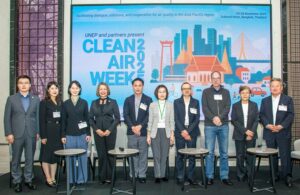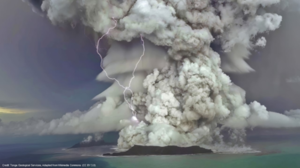Downscaling models: precious need for the regional level
The ongoing and future climate change brings its share of evolutions and it is essential to obtain a good visibility at a regional scale. However, improving the resolution of climate models require multifaceted actions. Davide Faranda, researcher at LSCE-IPSL, brings light on the need to improve local understanding especially regarding extreme events, and the underlying challenges.
To prepare coping with the impacts of climate change, stakeholders need a good understanding of risks and impacts at their regional scale. Yet, every region has its specificities and the different extreme climatic events can present various characteristics. And some of them, such as heavy rain, remain complex to predict because they are rare, extremely localised and difficult to observe. Davide Faranda, researcher in the ESTIMR team at LSCE-IPSL, uses a particular approach to understand why and how can extreme events change with global warming. The strategy is to try to define extreme events, not only through minimum and maximum values, but according to the associated weather conditions. “We study the atmospheric circulation, for instance pressure fields, to see if the location and intensity of cyclones and anticyclones can determine some extreme climatic events” indicates Davide Faranda.
Their global calculation approach aims at evaluating if the future rather holds stable atmospheric conditions ─ hot and dry days ─ or unstable ─ rainy and windy days. “We noticed[1] that a warmer ocean disrupt the chaotic properties of the atmosphere and would tend to bring more windy and rainy days to France, as it happened in May 2021” illustrates the researcher. Ocean warming translates in a modification of atmospheric circulation in the manner of a hammam. Nowadays, this continental-scale approach is adapted to specific cases such as the heavy rainfall of 2019 in France and Italy. The goal is to evaluate the share of responsibility of climate change in the occurrence of these events and how they can be affected by future climate evolutions.
The past: Compass for the future
Past events are a guide for researchers who often rely on databases operating since 1979 to analyse the characteristics of past events similar to the ones understudy today. In this way in the case of precipitation caused by thunderstorm, researchers will target corresponding past events and look for the associated atmospheric conditions. It can be the difference of temperature between the ground and the atmosphere for instance, partly responsible for thunderstorms by creating instability. And these pieces of information are also helpful to get projections for the future. Statistics on extreme events are valuable to evaluate the link with the ongoing and future climate change, in particular with thunderstorms. It is well-documented that continental surfaces are warming faster than the atmosphere. This difference could be responsible for a greater instability in the atmosphere, leading to more thunderstorms. But rainfall events are not all alike.
“Presently we cannot draw general conclusions of rainfall evolution, because each event has particular characteristics” declares Davide Faranda. “As a whole, these events show a stronger variability, with more intense rainfall and stronger drought periods” he adds. Specific extreme events are more complex to classify because they are not all related to the same mechanisms. Some are associated with cyclones or tropical storms like Alex that had made severe damage in the South of France. Others are related to storms which encompasses many different mechanisms depending on the origin of winds and humidity levels. “It gets interesting because we have to target differences among these classes of event” reveals Davide Faranda. These extreme events are also connected to very small scale mechanisms and require models with a sharp view of the atmosphere.
Downscaling challenges
And here goes the challenge for climate models. A storm formation involves a gathering of smaller clouds ─ cumulus ─ generally badly represented in models. They are often set by an average calculation of their effect. Thus, larger-scale associated mechanisms such as storms and rain are not ideally represented either. Step by step researchers improve the resolution of models to get this new layer of data and better insight on precipitations related to storms, particularly through better observation possibilities. “The use of “Doppler” radar to get a high-resolution observation of the shape and distribution of rainfall associated to storms grants access to a great visibility on storm clusters we didn’t have before” indicates Davide Faranda. But other aspects also need to be taken into consideration, such as regional geography.
A mountain range can have an effect on the location and intensity of different phenomenon or on the presence of snow, to cite but a few examples. The topography is then integrated in climate models but in a rough fashion considering a limited resolution. And when researchers downscale models to improve the resolution, going from a 30km to a 15km precision for instance, the topography has to be redesigned by adding the average height at every new point. “When we reach a certain threshold, with a grid size of 3km or 4km, we have to redefine equations: some hypothesis working for a wide grid size no longer work for smaller ones” explains the researcher. “As soon as we downscale atmospheric models and work on the equations, it is necessary to ask ourselves if the various atmospheric phenomenon and interactions with the ocean or the lithosphere are still well represented” he underlines.
Downscaling is crucial in modelisation to see small-scale phenomenon and in the end, study climate change’s impacts. This local visibility is also essential to stakeholders to anticipate and prepare for upcoming regional evolutions. “There has been a lot of modelisation efforts in some regions such as the Mediterranean Sea that will surely be put forward in the next IPCC report” specifies Davide Faranda. However other regions have been getting less attention and do not have a good resolution in models. Local data needs to be developed to accompany companies and stakeholders. In this spirit, IPSL has started climatic services so that climate scientists, industrials and stakeholders can work together to target specific needs and bring some light on some of them and set in place adaptation strategies to face climate change.
To go further
Discover the serious game ClimarisQ : A game for smartphone/web originating from a science mediation project that put forward the complexity of our climate system and the emergency of a collective action to limit climate change. This app game gives the possibility for players to take decisions to limit the frequency and intensity of extreme events.
[1] Davide Faranda, M Carmen Alvarez-Castro, G Messori, D Rodrigues, P Yiou. The hammam effect or how a warm ocean enhances large scale atmospheric predictability. Nature Communications, March 2019. DOI: 10.1038/s41467-019-09305-8






